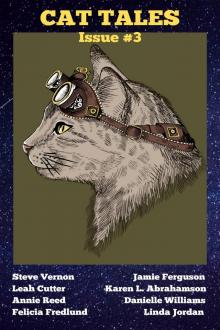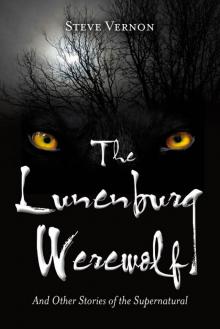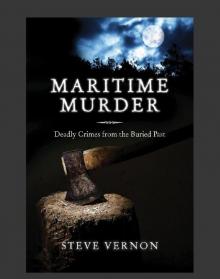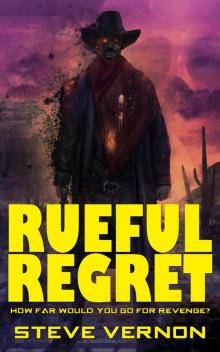- Home
- Steve Vernon
Wicked Woods Page 7
Wicked Woods Read online
Page 7
After reaching Hardings Point, stay on Route 845 and keep going straight, heading towards Kingston. It shouldn’t be that hard to find, on account of Route 845 is the only major road lead–ing from that end of the ferry. Ghost Hollow is about six minutes from Hardings Point at regular driving speed. You don’t actually see the hollow so much as drive into it. It is a stretch of road that drops down and stretches out in the basin of a deep old valley.
At least that’s how the directions were told to me.
It seems there were two brothers by the name of Laskey who lived on a small farm somewhere in the belly of Ghost Hollow. Some say they were twins and some say they just happened to look alike, as brothers sometimes do.
A small brook used to run through the hollow and one of the brothers, the younger one, got into the habit of sitting on a huge boulder by the brook, alongside the roadway, for his after-supper pipe.
They say that one night the younger Laskey brother fell asleep on the rock and took a chill, and before a week had clocked by he breathed his last breath and died.
Now having a brother pass on like that can affect a man. The other brother took his place on the rock. He would sit there and smoke his brother’s pipe, not saying a word. He’d just sit there and stare up at the sky.
Who knows what he was up to? Maybe he was trying to make mischief, or maybe he wasn’t trying anything at all. Maybe he was just sitting there and thinking about his brother and wondering to himself just what lay beyond those stars.
Word got out that the ghost of the young Laskey boy was haunt–ing the hollow. Folks who knew the story were always surprised to see him sitting there on that rock. When one of the cars ran off the road because the driver was so frightened, folks got to think–ing that maybe it was time to do something about the ghost of Ghost Hollow.
“We should send a priest,” they said, but no priest would go.
Finally, a brave young fisherman by the name of Andrew McTavish said he wouldn’t mind swinging down to the hollow to have himself a look.
“Might go down there and see what I can scare up,” he said.
So Andrew McTavish walked on over to Ghost Hollow, some–time after the sun had gone down.
“You’re not going down there in the darkness?” one of his bud–dies asked.
“Well, you don’t see too many ghosts in the daylight, do you?” Andrew retorted.
He walked down the long, slow hill that led into the hollow. The moon climbed up, a big, fat pumpkin of a moon that lit up the whole valley like it was daytime.
“A fine far night,” Andrew said, staring off into the heavens.
A hoot owl called out whoo, whoo?
“Just me,” Andrew said. “Nobody special at all.”
When he got close enough to the rock he could see the glint of the pipe bowl, flaring and gleaming as its owner puffed away.
“I’ll lay you odds that’s my ghost or my man,” Andrew whis–pered to himself.
And then, as he drew closer, he shouted out bold and plain. “Here now. I’ll have a word or two with you.”
The figure on the rock didn’t move one whit. He just sat there puffing on his pipe as if he were as deaf as a frozen winter stone.
“Are your ears stogged in?” Andrew asked. “I’ll have a word with you or know why you won’t speak.”
And still the figure sat there, puffing away. Andrew could see him now and he sure did look an awful lot like the Laskey boy, but then again, so did his brother.
Andrew bent down as he walked and scooped himself up a pocket full of rocks to throw.
“Here now,” he called out. “If you’re a man, speak up or I’ll make you speak.”
And he started pitching and flinging those rocks with deadly accuracy, shying them off the boulder the figure was sitting on. One or two of them hit the mark and the ghost finally spoke up.
“Hey!” he shouted.
Andrew stepped closer and picked up a good-sized chunk of stone.
“Now look here, mister man,” Andrew said. “This next rock will raise more than an ouch from you. Of course, being a ghost, I don’t reckon you’ve got all that much to fear, now do you?”
At that, the figure jumped up and skidded down the rock, dropping the pipe and spilling the ashes, and nearly breaking his leg. He didn’t stop for anything, just kept on running.
Andrew grinned at the sight.
“Well who’d have dreamt that a ghost could ever run so fast?” he said into the darkness.
And nobody but the old hoot owl answered him.
Who, indeed?
13
GHOST ROCK
LORNEVILLE
Lorneville was originally named Pisarinco by the clansmen who settled there. Pisarinco was a Maliseet term, prone to misinterpretation and, as were many native names, to unfortunate mis–pronunciation. In the late 1800s, the name was changed to Lorneville, in honour of Sir John Douglas Sutherland Campbell, the ninth Duke of Argyll and the Marquis of Lorne.
Now personally I think that Sir John had himself more than enough names to begin with, without bothering to name an entire settlement after himself, but the name was changed regardless.
Just off Lorneville Road, a little south–west of Saint John, is a spot folks used to call Ghost Rock. The rock stood just at the end of the road, directly between the fine white clapboard church and the brood–ing Lorneville Harbour. Now the rock isn’t there anymore, hav–ing been lost to an unfortunate demolition blast during develop–ment of the land, but folks still love to tell the story of the lonely maiden of Ghost Rock.
It was back in the late 1820s that James Trevarton, tall, lean captain of the brig Minerva, fell in love with one Florence Atherton and asked her for her hand in marriage. Unfortunately, Captain Trevarton was not alone in his infatuation. His first mate Davis Dugall had been watching the two together for some time, and he vowed to himself that he would have this beautiful black-haired woman.
Dugall harboured his hatred for the couple like a stone in his heart. He was certain that with the captain out of the way, Florence Atherton would yield to his suit. He waited for the cap–tain one night as the gentleman came whistling home after an evening of courting his sweetheart on her family’s front porch. It was his last night before he sailed away in the Minerva for another voyage at sea.
Dugall hid behind a lilac bush, holding a chunk of beach rock in his hand, and waited until his captain walked past.
The black-hearted rogue sprang out of the shadows and struck the captain stone dead with the rock. Trevarton fell to the dirt, and Dugall dragged his body down to the Ghost Rock and crammed it into a cranny beneath the heavy stone. He blocked up the crevice with some beach rock, daubed it in solid and snug with mud, and covered his work with a bit of driftwood and seaweed. What a careful craftsman he was. If he hadn’t found a future in sailing he might have made himself a fine life as a Maritime undertaker.
Then the cold-hearted devil made his way down to the Minerva.
“The captain’s been called away on business,” he swore to any who asked. “We’re to be away on the tide and he’ll meet us further down the coast.”
It took some convincing, but old Dugall was a pretty slick liar. In the end, the tide won out and the Minerva sailed away as it was scheduled to. Meanwhile, Florence Atherton remained at home, certain that her love was away to sea, never dreaming that he lay so very close to her doorstep.
A year later, Dugall fell overboard off the coast of Nantucket. Some swear that he jumped off the ship as a result of his bad conscience. In any case, when his belongings were searched a letter was found in his cabin confessing to the murder of Captain James Trevarton, along with a map showing the place his body was buried.
When the townsfolk of Lorneville dug up his body, Florence Atherton’s heart broke in two.
“At last I can rest,” she said, and by all accounts she fell dead upon the hard and unforgiving side of Ghost Rock.
Now there are more than a few holes in t
his particular tale. One wonders just how long a ship would sail without its captain and just why a murderer would bother drawing a map revealing the location of his victim’s body.
Wonder or not, it is true that folks in the area still claim that on cold, moonless, lonely nights a beautiful woman in a long grey bridal gown is seen walking these shores as the waves shatter into salty tears against the coast about her spectral feet. Even now that the rock has been reduced to gravel there aren’t many campers brave enough to spend a night on these shores.
14
THE PICKLE
BARREL WIFE
CAMPOBELLO ISLAND
Sometimes a name just won’t stay stuck. A place will spit a christened name out as easily as a fish slipping an unwanted lure.
Campobello Island dangles out of the mouth of the Bay of Fundy just north–west of Grand Manan Island like a lost fishing hook. The Passamaquoddy First Nations people, a peaceful fishing tribe whose name literally means “pollock-spearer,” originally called the island Ebaqhuit, which means “lying beside the land.”
Captain Cyprian Southack — famed privateer, cartographer, and treasure hunter— decided to rename Ebaqhuit in 1773, calling it the Great Island of Passamaquoddy. Folks who live there will tell you that while their island was pretty enough it was hardly worth calling great, but I guess old Southack must have been fairly impressed.
In 1770, the island was granted to William Owen, an officer of the Royal Navy who had lost an arm as the result of a wound suffered during the Seven Years’ War. The grant was a compen–sation for his work as an aide to Lord William Campbell. At the time, Lord William Campbell was the appointed governor of Nova Scotia. William Owen returned the favour by naming the island Campobello, which was a play on Campbell’s name and the Spanish/Italian word bello, meaning beautiful.
As a young man, Franklin Delano Roosevelt spent summers on Campobello and often sailed to Dark Harbour on Grand Manan Island, where he would happily dig on the beach, hunting for one of Captain Kidd’s many buried treasures. Roosevelt contracted the polio that eventually crippled him on Campobello, but went on to build himself a summer home here.
Folks on the more populated southwest end of Campobello Island will be happy to offer you a story of the Bingo Man, the spirit of an elderly gentleman who died of a heart attack one Monday night on his way to bingo and has since been spotted on most Monday nights, still hunting for the bingo hall.
That’s a quaint enough tale for some, I suppose, but pretty tame fare for any book of ghost stories I put together. Instead I’d like to offer you a little stronger meat. I’d prefer to tell you the tale of the nastier, less-populated northern end of Campobello Island. The northeast part of the island is mostly covered with sharp unas–sailable cliffs, spotted with snarling fir trees, poison sumac, and a few wild daisies like pearls amongst the cold, grey rocks.
There’s a natural cove at the northeast corner of the island that caves inward like an open mouth. They call it Mill Cove and there’s a small town nearby that is famed for its bear hunting and fishing. If you ask nicely, folks around Mill Cove will be more than pleased to tell you the grim little yarn of the carpenter John Dunbar and his pickle barrel wife.
Now look here close and give me a listen because I guarantee this one is a dilly of a tale.
John Dunbar of Mill Cove, New Brunswick, was a master carpenter who made a fair living raising houses, crafting furni–ture, working as a shipwright and making coffins. Between that he worked hard in a local sawmill. In short, he did whatever was needed to put money in his pocket.
I said he was a Maritimer, didn’t I?
Unfortunately, he put just as much money in the local tav–ern keeper’s pocket. John’s wife, Margaret, was rightly con–cerned by his habitual drunkenness and lack of foresight. She was constantly on the lookout for a little of his money to salt away.
Sometime around the year 1798, John Dunbar was commis–sioned to construct the very first gallows in Charlotte County, in the town of St. Andrews. The town is about thirty kilometres due north of the island. In those day that was a fair distance to go, but Dunbar needed the work. He was proud that they’d hired him, though some folks maintained that he got the job simply by being the cheapest carpenter in those parts.
“Mister man,” one villager said. “You never seen a fellow so jeezly cheap. He would squeeze a coin so tightly that old King George iii himself had to pause a moment and blush.”
And that’s where the whole problem started. John Dunbar was a poor carpenter, in both senses. He couldn’t charge all that much for his work because it wasn’t worth much in the first place. To make matters worse, he was determined to keep what little money he had from the grubbing hands of his wife. She would only spend it on bills and that, to John Dunbar, was a complete waste of good drinking money. He took the few gold coins that he earned from building the gallows in St. Andrews, and buried them in a hidey-hole behind the house where he figured they’d be safe. He wouldn’t tell his wife where he’d hidden the gold — the fact was he didn’t even tell his wife he had any gold to hide.
“The money went to the bills,” he swore. “It was blown to the four winds on this and that and half of nearly everything else.”
Well sir, Mrs. Dunbar’s mother never raised herself any fools. Margaret Dunbar knew darned well that old John had tucked that gold away somewhere to spend on his thirst. So she fixed him with one eye and nailed him with the other and kept a long, quiet watch on her husband’s comings and goings. You see, she knew well enough that old John liked to keep his assets liquid, so he could pour them out of his pocket and into the local barkeep’s open hands.
Margaret waited for her moment, like a still hunter waiting in a stand of trees for a shot at its prey. One night John Dunbar came home roaring drunk and not knowing any better. Margaret seized her chance.
“Where’s my money?” he called out. “I’m off to the tavern.”
“Your money is where you said you put it,” Margaret said. “Blown away to the four winds on this and that and half of nearly everything else.”
So old John teetered out to his hiding spot to sneak out a wee bit more of his hard-earned gold to buy himself a wee bit more rum. That was all the chance that Margaret Dunbar needed. She followed him out to the back of the house and watched as he rooted up the money. She didn’t even need to stay quiet or sneak around one bit. He was that drunk already that he didn’t even notice she was there.
Then, once he’d gone roaring on back towards the town pub, Margaret Dunbar dug up his gold and hid it away herself in a small iron box that she buried just up from the beach under a stone that she marked. Always a practical woman, she’d keep the money hidden there for household emergencies.
For a day and a week John Dunbar carried on, blissfully unaware that his stash of gold coins had been discretely pilfered. By and by, as the tide slipped in and out, he drank up another thirst, and the gold coin he’d been leaning on melted away in the barkeep’s hands. John Dunbar went out to his hiding place and found out the truth. The money was gone.
“Where did you hide it?” he howled, knowing right away where the money had got to.
“Hide what?” Margaret Dunbar asked. “Whatever are you talk–ing about?”
Now Margaret Dunbar was counting on the fact that John would be too proud to admit that he’d been outfoxed by a woman. Because he hadn’t told her of the gold, if he forced the issue, he would be accepting that she’d outsmarted him.
A reasonable man would have let the argument lay right there where he’d dropped it, but John Dunbar had built up a pretty serious thirst for rum. And never should it be said that master carpenter John Dunbar lived anywhere handy to the realm of reason.
They argued from noon until nightfall, and when the full moon was spying blindly down from the heavens above, John Dunlap picked up his broad axe and struck his wife squarely between her eyes.
Only he didn’t stop there. Fear and anger took hold of his very being
and the old devil cut his wife up into pieces and sunk the remaining chunks in the pickle barrel, in the root cellar directly underneath his house.
“Salt my money away, will you?” he said, as he dropped what was left of her into the barrel. “I’ll show you salt, I will.”
Old John kept his secret snugged deep within his guilty old soul for a full week and a half before mentioning his wife to anyone.
“She’s left town,” he would say. “She got tired of my drinking ways, I guess.”
And then he’d smile.
“Oh, she’s in a terrible pickle now, I’ll wager.”
And then he’d snigger, low and nasty, and would say no more. This went on for a couple of weeks, and then one night the rum got the best of him. Hunkered down over drink and cards the truth finally leaked out from his own lips like a trickle of brine leaking out of a pickle barrel.
Now John Dunlap was the one in a pickle. Quicker than you can say gherkin, they took him to the St. Andrews courthouse, and tried and convicted the carpenter, sentencing him to be hanged on the very gallows that he’d built.
A day before his execution he escaped. He fled to the town of Bayside, eleven kilometres from St. Andrews. Why did he stay so close by? Remember, eleven kilometres seemed considerably farther back in the days of horses and wagons. He found employ–ment there as a woodcutter, but was recognized right off and returned in chains to St. Andrews.
Only they didn’t hold him for very long. He escaped a sec–ond time and fled to Boston. Legend has it that a resident of St.
Andrews by the name of William Bentley was passing a house in Boston when he was struck on the head by a falling shingle. He looked up only to recognize John Dunbar, working with a crew patching the roof. Dunbar was taken back to St. Andrews and hanged. The third time was the charm, I reckon.
Treasure hunters still search the Mill Cove area hoping to find the missing Dunlap gold that was hidden by Margaret. Unless someone isn’t telling, that gold remains undiscovered. To this day, certain older citizens of Mill Cove swear they’ve heard the screams of Margaret Dunbar, low and hollow as if calling from a long way off, like perhaps from the bottom of a pickle barrel.

 Flash Virus: Episode One
Flash Virus: Episode One Cat Tales Issue #3
Cat Tales Issue #3 Cat Tales Issue #1
Cat Tales Issue #1 A Fine Sacrifice
A Fine Sacrifice The Lunenburg Werewolf
The Lunenburg Werewolf October Tales: Seven Creepy Stories (Stories to SERIOUSLY Creep You Out Book 1)
October Tales: Seven Creepy Stories (Stories to SERIOUSLY Creep You Out Book 1) Roadside Ghosts: A Collection of Horror and Dark Fantasy (Stories to SERIOUSLY Creep You Out Book 3)
Roadside Ghosts: A Collection of Horror and Dark Fantasy (Stories to SERIOUSLY Creep You Out Book 3) Haunted Harbours
Haunted Harbours Wicked Woods
Wicked Woods Two Fisted Nasty: A Novella and Three Short Stories (Stories to SERIOUSLY Creep You Out Book 2)
Two Fisted Nasty: A Novella and Three Short Stories (Stories to SERIOUSLY Creep You Out Book 2) A Hat Full of Stories: Three Weird West Tales (Stories to SERIOUSLY Creep You Out Book 9)
A Hat Full of Stories: Three Weird West Tales (Stories to SERIOUSLY Creep You Out Book 9) Bad Valentines: three twisted love stories (Stories To SERIOUSLY Creep You Out Book 7)
Bad Valentines: three twisted love stories (Stories To SERIOUSLY Creep You Out Book 7) Do-Overs and Detours - Eighteen Eerie Tales (Stories to SERIOUSLY Creep You Out Book 4)
Do-Overs and Detours - Eighteen Eerie Tales (Stories to SERIOUSLY Creep You Out Book 4) Tales From The Tangled Wood: Six Stories to SERIOUSLY Creep You Out
Tales From The Tangled Wood: Six Stories to SERIOUSLY Creep You Out Sinking Deeper
Sinking Deeper Bad Valentines 2: Six Twisted Love Stories (Stories to SERIOUSLY Creep You Out Book 5)
Bad Valentines 2: Six Twisted Love Stories (Stories to SERIOUSLY Creep You Out Book 5) Big Hairy Deal
Big Hairy Deal Maritime Murder
Maritime Murder Rueful Regret
Rueful Regret